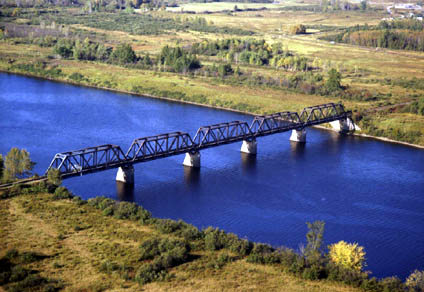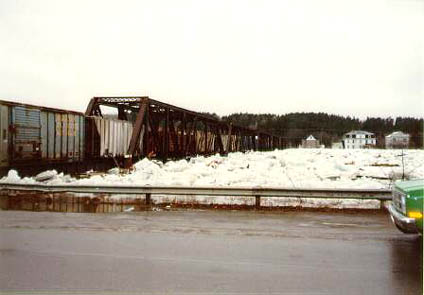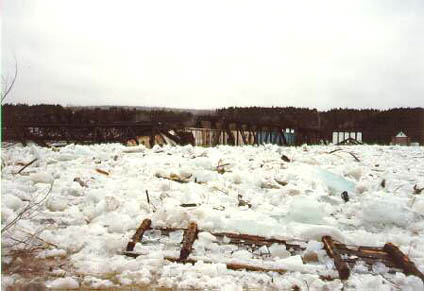Vol. 17 No. 9
September, 1987
|
Stay Safe in 87
|
|
CTC Clears Railway for
Using Cars to Protect Bridge

Typical St. John River
bridge.
Ottawa Ontario - The Canadian Transport Commission's Railway Transport
Committee (RTC) says CP Rail was not at fault when the railway used a number of cars in an attempt to stabilize a
bridge over the Saint John River at Perth-Andover, New Brunswick, on 2 Apr 1987.
The bridge and the cars eventually were swept away by an ice jam and flood waters.
The ice jam and high water on the bridge's superstructure pushed five 49-metre trusses and one
18-metre girder off its foundations, dumping 17 freight cars into the river. Thirteen of the cars
contained fertilizers, which were not considered or regulated as dangerous goods by the RTC.
CP Rail used loaded railway cars to stabilize the same bridge during flooding in 1976. The action taken by the
railway at that time was credited with saving the bridge, the RTC said.
The RTC report said that although the railway's selection of fertilizer cars to stabilize the bridge on
2 Apr 1987 was not a preferable one, the report said it was the only available choice under the
circumstances. Twenty-three cars loaded with wood chips were located 45 kilometres away, but were
cut-off by ice and flood waters.
The RTC accident report contained no recommendations, other than the observation that the terms of reference of the
Canada-New Brunswick Flood Damage Reduction Program should be reviewed and possibly enlarged with
particular attention given to ice jam formation and control.

Ice jam endangering a typical St. John River
bridge.

Typical St. John River bridge collapse due to ice jam and
flood.
As a result of damage to two CP Rail's bridges during this spring break-up and flood they made
application to abandon the Shogomoc Subdivision in New Brunswick which included these briges over the St. John River.
On 12 May 1989 under Order No. 1989-R-90 approval was granted to abandon the subdivision
because there was no reasonable probability of the branch lines becoming economic in the foreseeable future.
Furthermore, if the line were to be restored to a condition enabling rail service to resume over the portions of the
Subdivision included in the application, CP Rail, or the lessor, would be required to invest considerable sums to
replace the two washed-out bridges at mileage 54.0 and mileage 100.5.
This CP Rail News article is copyright
1987 by the Canadian Pacific Railway and is reprinted here with
their permission. All photographs, logos, and trademarks are the property of the Canadian Pacific Railway
Company.
|